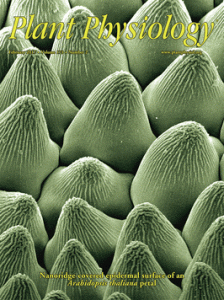 Researchers in China have retracted a paper and corrected three others in a plant journal, citing problems with multiple figures.
Researchers in China have retracted a paper and corrected three others in a plant journal, citing problems with multiple figures.
Lixin Zhang, from the Chinese Academy of Sciences in Beijing, is corresponding author on all four papers, published by Plant Physiology. We’ve reported on three retractions and two corrections from Lixin Zhang and some of the same co-authors, bringing Zhang’s total to five retractions and four corrections, by our count.
According to the retraction notice, the authors agreed to pull the article because of figure-related “irregularities and inappropriate data handling” — but despite these issues, they remain confident that their conclusions are still valid.
Here’s the latest retraction notice, issued this February, for “Cooperation of LPA3 and LPA2 Is Essential for Photosystem II Assembly in Arabidopsis:”
The authors of the above article are retracting it from Plant Physiology following an investigation into concerns of the origin and assembly of several figures. In Figure 2D, lanes labeled 1 and 0.5 of the wild type were duplicated. In Figure 4D, the “cloned” backgrounds were improperly used for the original images in three YFP panels (Alb3-NY+LPA1-CY, LPA1-NY+LPA3-CY, and LPA1-NY+LPA2-CY). In addition, two YFP/chlorophyll signals that were not in one field of vision in the LPA2-NY+LPA3-CY series of images were combined into the same frame. The characterizations of the lpa3 mutants have been repeated, and the results were reproduced in the authors’ laboratory. They are therefore confident that the conclusions of this article remain valid, namely that LPA3 is involved in PSII assembly, but are retracting the article because of the irregularities and inappropriate data handling. They apologize for the publication of this erroneous paper and deeply regret the inconvenience caused.
The 2010 paper has received 24 citations, according to Clarivate Analytics’ Web of Science, formerly part of Thomson Reuters.
The three corrections all deal with image-related issues, such as duplications and mislabeling. In one instance, the image background was inappropriately erased, and the original data couldn’t be found. The notices do not explain how the issues came to light.
Here’s the correction notice for the 2012 paper “DAC Is Involved in the Accumulation of the Cytochrome b6/f Complex in Arabidopsis,” which has received seven citations:
Figure 1D has been corrected to display the splice between wild-type and control samples by a black line on the same blot. The legend of the figure has been changed for clarity….
The notice describes mislabeling errors in Figure 7 as well:
The mislabeling of panels viii and ix in the Nuc-GFP row of Figure 7A has been corrected. The DAC blot of Figure 8A (lanes 8 and 9) was inadvertently duplicated in the published Figure 7B (PsbO panel), and the correct one is shown in the new version. The legend of Figure 7 has not been changed.
Finally, the notice provides a comparison of the original and corrected figures and concludes by reassuring readers that the corrections do not affect the article’s key conclusions:
For ease of comparison, the original and corrected versions of Figure 1 and Figure 7 affected by this mistake are presented below with the positions of the errors and corrections marked with red boxes. The original conclusions of this article are not affected by these corrections.
Here’s the second correction notice for the 2009 paper “LPA66 Is Required for Editing psbF Chloroplast Transcripts in Arabidopsis,” which required the authors to duplicate an experiment after the original data went missing:
In Figure 6A, the background of the image of the psbD polysome profile for lpa66 was erased inappropriately. The original data could not be found, thus Figure 6A was reconstituted with the data from a duplicated experiment. The legend was revised accordingly. The original conclusions of this article are not affected by these corrections. The original and corrected versions of this figure are presented with the corrected version of the figure indicated.
The 2009 paper has received 62 citations.
And here’s the third correction notice, for “The Pentratricopeptide Repeat Protein DELAYED GREENING1 Is Involved in the Regulation of Early Chloroplast Development and Chloroplast Gene Expression in Arabidopsis,” published in 2008 and cited 47 times:
The revised Figure 5D shown below is the result of an independent replicate experiment that corrects a copy-and-paste error that occurred during the preparation of Figure 5D for the published article. The legend was modified accordingly. The original conclusions of this article are not affected by this correction. For ease of comparison, the original and corrected versions of Figure 5 affected by this mistake are presented below with the positions of the errors and corrections marked with a red box.
In addition to Zhang, many of the same coauthors appear on multiple papers and all are based at the Chinese Academy of Sciences in Beijing.
We’ve contacted Zhang and some other authors, as well as the journal’s editor-in-chief Michael R. Blatt, a professor of botany at the University of Glasgow.
Last year, we covered a retraction by The Plant Cell for a 2007 paper by Zhang and several of the coauthors over image duplication and manipulation, for which Zhang took responsibility. We have since discovered that notice included another paper by Zhang.
“LOW PSII ACCUMULATION1 is involved in efficient assembly of photosystem II in Arabidopsis thaliana” has been cited 124 times since it was published in 2006.
Like Retraction Watch? Consider making a tax-deductible contribution to support our growth. You can also follow us on Twitter, like us on Facebook, add us to your RSS reader, sign up on our homepage for an email every time there’s a new post, or subscribe to our daily digest. Click here to review our Comments Policy. For a sneak peek at what we’re working on, click here.